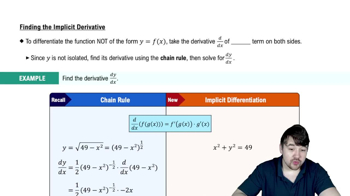Table of contents
- 0. Functions7h 52m
- Introduction to Functions16m
- Piecewise Functions10m
- Properties of Functions9m
- Common Functions1h 8m
- Transformations5m
- Combining Functions27m
- Exponent rules32m
- Exponential Functions28m
- Logarithmic Functions24m
- Properties of Logarithms34m
- Exponential & Logarithmic Equations35m
- Introduction to Trigonometric Functions38m
- Graphs of Trigonometric Functions44m
- Trigonometric Identities47m
- Inverse Trigonometric Functions48m
- 1. Limits and Continuity2h 2m
- 2. Intro to Derivatives1h 33m
- 3. Techniques of Differentiation3h 18m
- 4. Applications of Derivatives2h 38m
- 5. Graphical Applications of Derivatives6h 2m
- 6. Derivatives of Inverse, Exponential, & Logarithmic Functions2h 37m
- 7. Antiderivatives & Indefinite Integrals1h 26m
- 8. Definite Integrals4h 44m
- 9. Graphical Applications of Integrals2h 27m
- 10. Physics Applications of Integrals 2h 22m
4. Applications of Derivatives
Implicit Differentiation
Problem 69a
Textbook Question
The following equations implicitly define one or more functions.
a. Find dy/dx using implicit differentiation.
x+y³−xy=1 (Hint: Rewrite as y³−1=xy−x and then factor both sides.)
 Verified step by step guidance
Verified step by step guidance1
Start by rewriting the given equation as suggested: \( y^3 - 1 = xy - x \). This will help in factoring both sides.
Factor both sides of the equation. The left side \( y^3 - 1 \) can be factored as \( (y - 1)(y^2 + y + 1) \). The right side \( xy - x \) can be factored as \( x(y - 1) \).
Now, set the factored forms equal to each other: \( (y - 1)(y^2 + y + 1) = x(y - 1) \). Notice that \( y - 1 \) is a common factor on both sides.
Divide both sides by \( y - 1 \) (assuming \( y \neq 1 \) to avoid division by zero), which simplifies the equation to \( y^2 + y + 1 = x \).
Differentiate both sides with respect to \( x \) using implicit differentiation. For the left side, differentiate \( y^2 + y + 1 \) with respect to \( x \) using the chain rule, and for the right side, differentiate \( x \) directly. This will give you an expression for \( \frac{dy}{dx} \).
 Verified video answer for a similar problem:
Verified video answer for a similar problem:This video solution was recommended by our tutors as helpful for the problem above
Video duration:
4mPlay a video:
Was this helpful?
Key Concepts
Here are the essential concepts you must grasp in order to answer the question correctly.
Implicit Differentiation
Implicit differentiation is a technique used to differentiate equations where the dependent and independent variables are not explicitly separated. Instead of solving for y in terms of x, we differentiate both sides of the equation with respect to x, applying the chain rule when necessary. This method is particularly useful for equations that define y implicitly, allowing us to find dy/dx without isolating y.
Recommended video:

Finding The Implicit Derivative
Chain Rule
The chain rule is a fundamental principle in calculus that allows us to differentiate composite functions. It states that if a function y is defined as a function of u, which in turn is a function of x, then the derivative of y with respect to x can be found by multiplying the derivative of y with respect to u by the derivative of u with respect to x. This rule is essential when applying implicit differentiation, as it helps manage the derivatives of terms involving y.
Recommended video:

Intro to the Chain Rule
Factoring
Factoring is the process of breaking down an expression into simpler components, or factors, that can be multiplied together to obtain the original expression. In the context of the given problem, factoring can simplify the equation after rewriting it, making it easier to differentiate. Understanding how to factor polynomials and other expressions is crucial for manipulating equations effectively in calculus.
Recommended video:

Limits of Rational Functions: Denominator = 0

 5:14m
5:14mWatch next
Master Finding The Implicit Derivative with a bite sized video explanation from Nick
Start learningRelated Videos
Related Practice


